|
|
|
Sort Order |
|
|
|
Items / Page
|
|
|
|
|
|
|
| Srl | Item |
| 1 |
ID:
131763


|
|
|
|
|
| Publication |
2014.
|
| Summary/Abstract |
This article argues that the Aden Insurgency was a pivotal moment in the history of British counter-insurgency. We argue that it was in Aden where the newfound strength of human rights discourse, embodied in Amnesty International, and of anti-colonial sentiment, expressed by the UN General Assembly, forced the British government to pay attention to public perceptions of colonial brutality. Using archival sources, we foreground three episodes in the history of the insurgency to support our argument and to illustrate that the changes witnessed were not the result of 'learning' but of a fundamental shift in the international environment.
|
|
|
|
|
|
|
|
|
|
|
|
|
|
|
|
| 2 |
ID:
130888
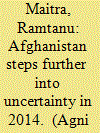

|
|
|
|
|
| Publication |
2014.
|
| Summary/Abstract |
2014 was long anticipated as the year of transition and ushering in of hope for Afghanistan. Three months of this important year are already behind us and, betraying earlier expectations, afghans continue to face stark uncertainties.
|
|
|
|
|
|
|
|
|
|
|
|
|
|
|
|
| 3 |
ID:
132298
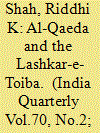

|
|
|
|
|
| Publication |
2014.
|
| Summary/Abstract |
Study of ideology is one of the most important domains of consideration for a successful counter-terrorism strategy. It is necessary to know and understand the ideology of a terrorist outfit coupled with the ongoing evolution at the same, its chief ideologues and its target audiences in order to provide an alternative ideology or in other words to win the 'hearts and the minds' of the people. This article traces the mounting similitude in the discourse and the actions of Lashkar-e-Taiba and the ideology of Al-Qaeda. The article begins with a brief depiction of the debate on the 'end of ideology' before proceeding on to an examination of Al-Qaeda's ideology. In the next section, LeT's discourse and actions from 1990 to 2010 are scrutinised followed by an analysis that attempts to draw out parallels between the ideologies of the two terrorist organisations. In the last section, the conclusion raises several pertinent points for the consideration of counter-terrorist specialists and policy makers.
|
|
|
|
|
|
|
|
|
|
|
|
|
|
|
|
| 4 |
ID:
131984
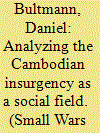

|
|
|
|
|
| Publication |
2014.
|
| Summary/Abstract |
This article investigates power practices in the Cambodian insurgency after 1979 as being part of a social field. There are various types of power practice being exercised by commanders aiming at making soldiers disciplined inside the insurgency. The hypothesis explaining these variations being proposed here is that the type of power being exercised depends on the habitus of the respective commander. Power practices are shaped by the incorporated classificatory discourse of commanders on good soldierhood and leadership. Thereby, armed groups can be analyzed as a social field in which practices are always relational and part of symbolic struggles between different commanders.
|
|
|
|
|
|
|
|
|
|
|
|
|
|
|
|
| 5 |
ID:
130235
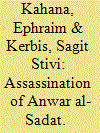

|
|
|
|
|
| Publication |
2014.
|
| Summary/Abstract |
Within the context of intelligence, the assassination of Egypt's President Muhammad Anwar al-Sadat on 6 October 1981 can be characterized as both a symbolic security failure and a failure to implement professional security principles by those responsible for guarding his life.
The circumstances creating the security "hole" were not confined to the short period preceding the assassination, but rather began long before, as part of an intense clash between two conflicting forces: extreme Islam and modern statehood.
In contrast to prevailing opinion, the apex of the struggle between these two forces is the main reason for the assassination, and not Sadat's peace with Israel. 1 The assassins of the al-Jihad group, springing unchecked from the substratum of fundamentalist Islam, carried out their work resolutely, exploiting the circumstances with almost incredible ease.
The sixth of October, observed in Egypt as a day of military triumph over the Israel Defense Forces (IDF) in the October 1973 War (the Yom Kippur War), is celebrated as an official holiday at the Grave of the Unknown Soldier on the outskirts of Cairo. On that date in 1981, on the reviewing stand stood President Sadat and his entourage: Vice President Hosni Mubarak; Defense Minister Mohammad Abu-Gazala; members of parliament; and members of the diplomatic corps, among them Israeli Ambassador Moshe Sassón.
Mirage fighter planes flew in celebratory formation above, and all in attendance were occupied with watching them and the huge parade passing before the reviewing stand, as columns of soldiers marched past the proud president.
When it was the artillery unit's turn to pass, a military truck stopped suddenly, from which four uniformed men sprang. Thinking this was part of the pageantry, no security personnel acted to prevent them from approaching the reviewing stand. One of the men quickly threw a grenade that did not explode, followed by more grenades. The assassins cocked their weapons and charged, firing at those on the reviewing stand.
The speed and suddenness with which the assassination was carried out resulted in pandemonium. People ran in all directions to take cover while Sadat stood, stiff and in shock, making him a clear target for sniper Hussein Abbas, 2 who shot him in the neck and chest. Sadat collapsed on the spot, yet this did not prevent another assassin, Abed al-Hamid, from emptying the rest of his rifle's magazine unhindered to confirm the kill. Sadat was flown by Gazelle helicopter to the Armed Forces Military Hospital at Ma'adi, but he arrived with no pulse, as his chest and arteries had been fatally penetrated.
The individual responsible for the assassination was Captain Khalid al-Islambouli. The fact that he and his partners managed to carry out this "inside job," despite explicit warnings having been received of threats on the president's life at the parade, testifies to a complete absence of common sense on the part of the Egyptian security sector.
The head of the Israeli security unit and lead investigator of the assassination, who was also responsible for Ambassador Sasson's rescue, was Avraham Rotem. According to Rotem, some members of Sadat's security detail were known to Rotem's unit personally due to previous reciprocal visits between Israeli and Egyptian personnel. 3 For this reason, the part played by Egyptian security personnel that day remains a mystery, due precisely to Israel's familiarity with them and the fact that they had acquired their security expertise from the best American instructional training. Sadat's assassination therefore raises a number of burning questions emanating from the fact that many in the upper Egyptian echelons knew that Sadat was in the opposition's crosshairs.
|
|
|
|
|
|
|
|
|
|
|
|
|
|
|
|
| 6 |
ID:
090448
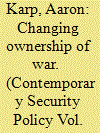

|
|
|
|
|
| Publication |
2009.
|
| Summary/Abstract |
As the state loses not only its Weberian monopoly over legitimate violence, but also its control over military initiative and dominance of military technology, what forces lead the redefinition of the ends and means of armed violence? If non-state armed groups are understood as the new owners of war, how must our understanding of the artefacts of violence adapt as well? This article examines the effects of changes in the legitimacy of violence on its physical manifestations. Weapons technologies have ceased to be an independent variable of violence and become consequences of strategic and doctrinal choice. As states lose the ability to use technology to regulate warfare, technological virtuosity no longer is defined by the state, but by the initiators of violence. It follows that the most important violent technologies no longer are state-generated. They are adaptations and creations by terrorists and insurgents. This transformation affects priorities and possibilities for control over violent technology. Innovative statist methods - as developed through the Proliferation Security Initiative (PSI) and UNSC 1540 - remain highly relevant, as do Westphalian concepts such as export control and disarmament. Recognizing limits to their effectiveness in an environment where rules are set by non-state actors as much as by states themselves, however, is crucial
|
|
|
|
|
|
|
|
|
|
|
|
|
|
|
|
| 7 |
ID:
131024
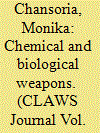

|
|
|
|
|
| Publication |
2014.
|
| Summary/Abstract |
In a March 2014 report, the United Nations human rights investigators con?rmed that chemical weapons were indeed used in Syria in 2013, which apparently came from the stockpiles of the Syrian military, whose chemical weapons stash reportedly included mustard gas. The report con?rmed that the deadly nerve agent Sarin was used in three separate incidents: the Damascus suburb ofal-Ghouta in August 2013, Khan al-Assal in March 2013 and Saraqeb near the northern town of ldlih in April 2013. While the Bashar al-Assad government and the Syrian opposition indict each other of using chemical weapons, which are strictly banned as per existing international law and convention, the incidents amount to being the deadliest chemical attacks the world has witnessed in almost a quarter of a century.
|
|
|
|
|
|
|
|
|
|
|
|
|
|
|
|
| 8 |
ID:
131338
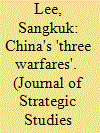

|
|
|
|
|
| Publication |
2014.
|
| Summary/Abstract |
Entering the twenty-first century, China has demonstrated an assertive foreign policy, not only in employing various types of economic and military leverage but also in conducting the Three Warfares (??) - psychological warfare, public opinion warfare, and legal warfare. This article attempts to identify the motives and methods of China's Three Warfares by analyzing its history, logic, and agents. Based on this analysis, the author also presents the position of the Three Warfares in China's foreign policy and the warfares' impact on the international security environment involving other major powers and China's neighbors.
|
|
|
|
|
|
|
|
|
|
|
|
|
|
|
|
| 9 |
ID:
130986
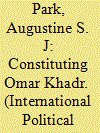

|
|
|
|
|
| Publication |
2014.
|
| Summary/Abstract |
Until 2012, Omar Khadr was both the only former child soldier and Western national left in Guantanamo Bay. Captured by US forces at the age of 15, this Canadian youth would spend more than 40% of his life in US custody during the War on Terror. This article advances two key arguments. First, as a child soldier, Khadr is simultaneously cast as an object of sympathy and suspicion. The construction of Khadr's childhood is animated by a cultural racism, which casts Khadr as both a victim of an extremist family and the evil outcome of a "jihadi" upbringing. Second, this article examines competing culturally racialized claims about citizenship, prompted by the failure of the Canadian government to seek Khadr's repatriation. While the central preoccupation of liberal citizenship discourse is the erosion of Canada's identity as a Western, liberal democracy, "racial-nationalist" discourse raises the alarm on the threat posed by "citizens of convenience" who must be cast out of the polity through practices of "pure exclusion."
|
|
|
|
|
|
|
|
|
|
|
|
|
|
|
|
| 10 |
ID:
131031
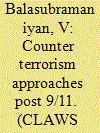

|
|
|
|
|
| Publication |
2014.
|
| Summary/Abstract |
Most studies on terrorism and political violence by experts and researchers have focussed on the causation factors of terrorism over the years. A majority of the scholarly works has mostly focussed on the historical, ideological, and etiological aspects of terrorism and insurgency. Scholars, researchers and investigators have attempted to epitomise and de?ne terrorism as a phenomenon, and have admitted to the problems in ?nding a universally acceptable de?nition. They have primarily focussed on bringing out an acceptable definition of terrorism in all its manifestations and forms, and in the process, have analysed the roots, origins and growth of terrorism. Compared to the enormous literature on the growth and incline of terrorism the world over, studies or scholarly works on the decline of terrorism or insurgency are not as vast and are limited in number.' A few experts like Martha Crenshaw and Audrey Cronin have dealt with this aspect in detail.' However, these attempts comprise only a fragment of the total terrorism literature in place.
|
|
|
|
|
|
|
|
|
|
|
|
|
|
|
|
| 11 |
ID:
130699
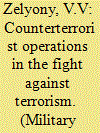

|
|
|
|
|
| Publication |
2014.
|
| Summary/Abstract |
With reference to special measures taken by the Israeli authorities, the author examines the nature and specific aspects of counterterrorist operations, suggest his own definition and develops a classification of the fight against terrorism.
|
|
|
|
|
|
|
|
|
|
|
|
|
|
|
|
| 12 |
ID:
132322


|
|
|
|
|
| Publication |
2014.
|
| Summary/Abstract |
The phenomenon of suicide attacks has dramatically expanded over the last twenty years, rising from no events in 1980 to a total of 1,398 events by 2008. A prominent theory has argued that suicide attacks are a coercive strategy aimed at ending foreign military occupation by democracies. Yet these conclusions are based on a research design that is affected by selection bias and that fails to distinguish foreign occupations from cases of groups seeking independence or autonomy, which we term domestic occupations. Analyzing an original data set that distinguishes the different types of occupation, we find that only foreign occupations have a strong and consistent effect on the incidence of suicide attacks. The reason, we argue, is that suicide attacks only become cost effective when targets are both hardened and accessible, a strategic environment that is more common to civil wars and foreign occupations than to domestic occupations.
|
|
|
|
|
|
|
|
|
|
|
|
|
|
|
|
| 13 |
ID:
131319
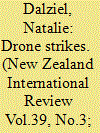

|
|
|
|
|
| Publication |
2014.
|
| Summary/Abstract |
As New Zealand's role in Afghanistan comes to a close, the War on Terror has been relegated to the backseat of the New Zealand public's consciousness, albeit prematurely so. With the first New Zealander killed in a drone strike in Yemen, it is timely that New Zealand reconsider its support for a tactic that opponents argue is itself an act of terrorism. As yet no consensus has been reached as to whether drone strikes constitute a breach of international law. We must, therefore, base our assessment on whether the tactic is ethically and strategically flawed. With every hell-fire missile that Nobel Peace Prize winning Barack Obama rains down on al-Qaeda and any civilians unfortunate enough to be in the way, a New Zealand decision on this question becomes more urgent.
|
|
|
|
|
|
|
|
|
|
|
|
|
|
|
|
| 14 |
ID:
131472
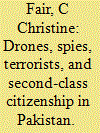

|
|
|
|
|
| Publication |
2014.
|
| Summary/Abstract |
This essay reviews seven recent books and reports that focus upon the use of US armed drones in Pakistan's Federally Administered Tribal Areas (FATA). This essay synthesizes a historical account of the program, critically interrogates key arguments and evidence advanced by the authors, and draws attention the particular problems that confront those who live in the FATA and the second-class citizenship that the Pakistani state has bestowed upon them for reasons of domestic and foreign policy concerns. This review essay does not intend to be the final word on any of the ongoing policy debates. But it does hope to enable a wider audience to take part in these important deliberations.
|
|
|
|
|
|
|
|
|
|
|
|
|
|
|
|
| 15 |
ID:
188326
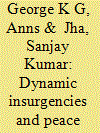

|
|
|
|
|
| Summary/Abstract |
The intended purpose of this paper is to examine the viability of political resolution as a counterinsurgency strategy. We have selected numerous political negotiation processes between insurgents and government of India in general and Mizoram in particular. The political resolution with Mizo National Front is considered as the most successful counterinsurgency operation in India. Placing this as a model, the government of India employed the strategy of negotiation with various other insurgent groups. The degree of success in Mizoram was not replicated in other insurgency theatres. This was analyzed with the help of a comparative study with other insurgent groups in India, particularly within the state of Assam. It is found that the model of Mizo resolution has been influencing the peace process that came later. And also the strategy of negotiation has been evolving into incorporating civil society groups as signatories to the final peace settlement signed between insurgents and government. This analysis of the peace process is also based on the conceptualization developed from various authors.
|
|
|
|
|
|
|
|
|
|
|
|
|
|
|
|
| 16 |
ID:
131057
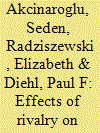

|
|
|
|
|
| Publication |
2014.
|
| Summary/Abstract |
The paper investigates how states manage multiple rivalries when faced with immediate threats. We argue that accommodation of one rival allows states to shift resources from the management of another rival to deal with the costs of immediate threats. By examining enduring rivalries from 1966 to 1999, we show that states' reliance on accommodation in response to threats varies depending on the number of severe threats and the relative capabilities between the states and the threat-issuing rivals. Findings show that when faced with severe but few threats, states prefer to accommodate rivals that did not issue the threat. They are also more likely to give larger concessions to such rivals and to those issuing less severe threats. Finally, the greater the military capability of a rival issuing a severe threat relative to that of the challenged state, the more likely that a threatening rival is accommodated.
|
|
|
|
|
|
|
|
|
|
|
|
|
|
|
|
| 17 |
ID:
131982
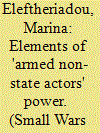

|
|
|
|
|
| Publication |
2014.
|
| Summary/Abstract |
Over the past few years there is an apparent re-regionalization of al-Qaeda activity, intensified by the ongoing Middle East turmoil. Its main characteristic is a trend towards the abandonment of focoist strategies and their replacement by more popular-based ones. This article aims at evaluating their capacity to implement such a strategy shift and sustain the required level of violence. As a means of evaluating this capacity, this article proposes the use of a DIME (diplomatic, informational, military, and economic) framework, which will hopefully provide an alternative angle of theorizing and understanding 'armed non-state actors' (ANSAs). The model is applied in the case of al-Qaeda in the Arabian Peninsula (AQAP), which appears to have effectively developed the military and informational dimensions, due partly to its own prowess and partly to the Yemeni state's weaknesses and the shortcomings of counterinsurgency. In contrast, the economic and diplomatic dimensions suffer from the lack of resources and the anti-systemic nature of AQAP.
|
|
|
|
|
|
|
|
|
|
|
|
|
|
|
|
| 18 |
ID:
130599
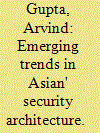

|
|
|
|
|
| Publication |
2014.
|
| Summary/Abstract |
The centre of gravity of international relations is shifting to Asia Pacific. The Asian region has been characterized by intense cold war rivalries; numerous territorial and maritime disputes, undemocratic A and oppressive regimes. The United States has been involved as an 'anchor of security in the region. Asian countries have seen acute financial crisis in the past. Many countries have been victims of terrorism, insurgencies, militancy, and fundamentalism. Resource Iigompetition is intensifying. Proliferation of weapons of mass destruction (WMD), presents a threat to the region. The past has "also been tainted with massive violence and bloodshed. The Korean _?._are claimed two million lives and the Vietnam War took three million fives. Internal pogroms by Khmer rouge claimed two million lives. .me of these issues like the divided Korean peninsula and the cross- t tensions between China and Taiwan still persist. The region
[nines to face formidable security challenges.
|
|
|
|
|
|
|
|
|
|
|
|
|
|
|
|
| 19 |
ID:
132260
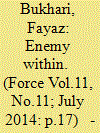

|
|
|
|
|
| Publication |
2014.
|
| Summary/Abstract |
This year the Indian Army achieved a major success by killing 41 militants including 11 top commanders of Lashkar-e-Toiba (LeT), Jaish-e-Mohammad (JeM) and Hizbul Mujahideen (HM) and arrested 23 of them in joint operations with the police.
The figures reveal that this is more than the number of militants neutralised last year, but over the years killing of militants is not making much of a difference as new recruits replace them.
Lieutenant General Subrata Saha, who took over as the General Officer Commanding (GOC) of Army's strategic Chinar Corps or 15 Corps, responsible for tackling militancy in Kashmir besides guarding the Line of Control (LC), has a bigger challenge ahead. For him, killing the militancy is a challenge and not counting the dead.
As per the figures given by the Jammu and Kashmir Police, there are 130 active militants in Kashmir valley and if the rate at which they were eliminated this year continues, not a single militant will be left by next year.
Says a senior army officer: "That is not the case, as per our records at least 16 Kashmiri youth, mostly educated, joined militancy this year. The numbers could be more than our records. And on an average two-three youth get lured into militancy during the funeral of a militant commander."
|
|
|
|
|
|
|
|
|
|
|
|
|
|
|
|
| 20 |
ID:
180903
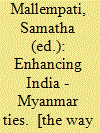

|
|
|
|
|
| Publication |
New Delhi, KW Publishers Pvt Ltd, 2021.
|
| Description |
xviii, 122p.hbk
|
| Series |
Sapru House Soundings on Area Studies
|
| Standard Number |
9789383445516
|
|
|
|
|
|
|
|
|
|
|
|
Copies: C:1/I:0,R:0,Q:0
Circulation
| Accession# | Call# | Current Location | Status | Policy | Location |
| 060052 | 327.54059/MAL 060052 | Main | On Shelf | General | |
|
|
|
|
|
|
|
|
|